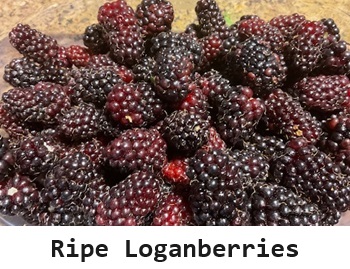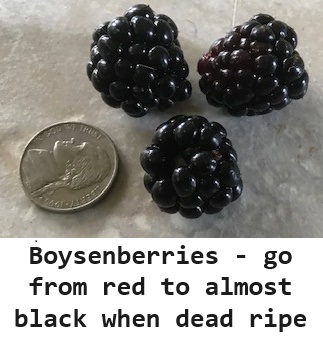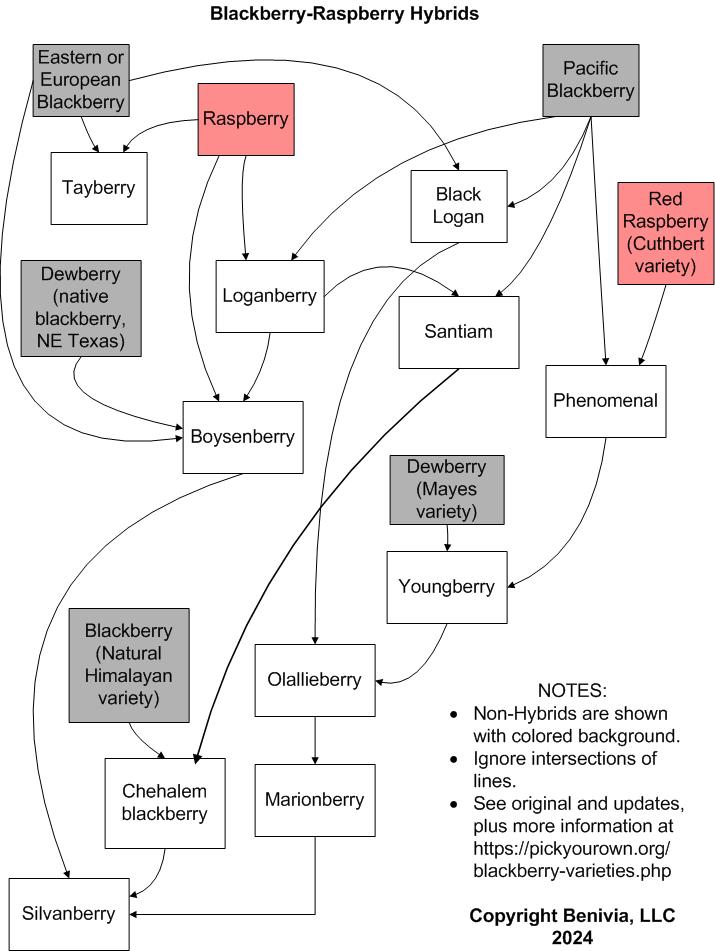
Looking for Blackberry Varieties in 2025? Scroll down this page and follow the links. And if you bring home some fruit or vegetables and want to can, freeze, make jam, salsa or pickles, see this page for simple, reliable, illustrated canning, freezing or preserving directions. There are plenty of other related resources, click on the resources dropdown above. If you are having a hard time finding canning lids, I've used these, and they're a great price & ship in 2 days.
If you have questions or feedback, please let me know! There are affiliate links on this page. Read our disclosure policy to learn more.
What's in season in December 2025, and other timely information:

Notes for December 2025: Summer is almost over and that means apples are here (see this new page for Apple Orchards in your area!), and except in northern areas, peaches and blueberries are finished. Some crops continue until frost, like raspberries, blackberries, figs, corn and tomatoes. Check your area's specific crop calendar (see this page) and call your local farms for seasonal updates.
See these pages to find a local Apple festival, and other festivals. We have a guide to apple varieties and a guide to peach varieties. Also recipes, canning and freezing directions for apples, tomatoes, corn blueberries, peaches, etc.
Don't forget about corn mazes and hayrides!
See our comprehensive list of easy home canning, jam and jelly making, preserving, drying and freezing directions. You can access recipes and other resources from the drop down menus at the top of the page or the site search. If you have any questions or suggestions, feel free to write me! It is easy to make your own ice cream, even gelato, or low fat or low sugar ice cream - see this page. Also note, there are many copycat website listing U-pick farms now. They have all copied their information from here and usually do not ever update. Since 2002, I've been updating the information every day but Christmas; so if you see anything wrong or outdated, please write me!
Guide to Blackberry Varieties
Blackberry Varieties
In
the U.S. Blackberries typically peak during June in the South, and in July in
the North. Crops are ready at various times of the month depending on which part
of the state you are located. In order to produce good local Blackberries,
producers depend on ideal spring and early summer weather conditions.
See this page for a list of
blackberry festivals around the U.S. The original wild blackberry, often found in
hedgerows along the side of the road has a tart intense flavor and is usually smal, 1/2 inch across. They make excellent crumbles, jam and pair well
with peaches and other berries, especially those with milder flavors, like strawberries. The semi-upright canes can be thorny or thornless and many
people swear that the flavor is stronger in thorny varieties and in wild blackberries. The seeds can be removed to make a seedless jam or jelly
using a Foley food mill (or you can train monkeys to do that, but they are very messy... )
The original wild blackberry, often found in
hedgerows along the side of the road has a tart intense flavor and is usually smal, 1/2 inch across. They make excellent crumbles, jam and pair well
with peaches and other berries, especially those with milder flavors, like strawberries. The semi-upright canes can be thorny or thornless and many
people swear that the flavor is stronger in thorny varieties and in wild blackberries. The seeds can be removed to make a seedless jam or jelly
using a Foley food mill (or you can train monkeys to do that, but they are very messy... )
Thorny or thornless?
The thorny varieties, especially Kiowa tend to have a more intense flavor, but... those thorns. Kiowa berries are so huge, though, that you can navigate around the thorns pretty well.
Single crop (June - July)
Click the links to order plants!
- Apache - largest thornless upright berry
- Arapaho - thornless upright excellent berry
- Chester - popular thornless blackberry
- Natchez - Very large berry, thornless upright
- Quachita - Upright thornless variety, large berry, excellent flavor
- Kiowa - Extremely large with best quality of all varieties, thorny. It is thorny, but the flavor and size make it one of my favorites.
-
Navaho
- Thornless erect, very large fruit highly recommended

- Darrow - Thorny, exceptionally large, tasty, sugar sweet berry that just keeps on producing
- Triple Crown - Another popular upright growing variety.
- Tupi - Thorny and super large
Blackberry Raspberry Hybrid Mixes
Plant scientists have been cross-breeding blackberries with raspberries and then again with each other to produce an almost endless number and tasty variants!
-
Boysenberry - a boysenberry is a cross between raspberries, blackberries, the American dewberry and a loganberry. It's like a medium
sized blackberry with a red-deep maroon color and large seeds. It has a flavor similar to a Tayberry, just not as intense. Most varieties are
thornless vines which makes harvesting very easy.
See this page for more information and farms that have Boysenberries. - Chuckleberries - While you might get a laugh out of the chuckleberry, the chuckleberry is a hybrid mix of a redcurrant, blackcurrant
and a gooseberry. It is reputed to have a strong, aromatic flavour.
- Cloudberry - an orange edible raspberry-like fruit they are popular in Sweden are native to Arctic and subarctic regions of the
northern hemisphere, such as Scandinavia, Russia, Canada
- Dewberry - Similar to blackberries, but have far fewer drupelets and are smaller. They're most popular in the U.S. Pacific northwest,
particularly Oregon. Dewberries have sprawling stems that trail along the ground, and grow roots along the length of the stem. The
stems have fine spines like a Tayberry. The berries, like most brambles start out green,turn red and then become a deep purple-blue. The berries
are very small and soft, so they are rarely grown commercially.
-
Loganberry - a blackberry and red raspberry cross, it is purple almost black when ripe. Only the Tayberry is more flavorful. The
Loganberry tastes like a mix of blackberries, raspberries and strawberries. .
- Marionberry - Rare in the UK, it is mainly grown in Oregon, but it is like a larger and sweeter blackberry.
It is mainly grown in Oregon where it is very popular and the main blackberry variety for jellies.

- Olallieberry - Rare in the UK, it is mainly grown in California. They are almost as sweet and plump as a Marionberry, just a bit
smaller. But they have a cult-like following among native Californians.
- Salmonberry - Mostly grown in the U.S. Pacific northwest, it is a small round, flavorful orange berry, very tart, thorny vines that
grown on the ground.
- Silvanberry - This Marionberry - boysenberry hybrid is large, dark red to black and tasty.
Most commonly grown in Australia. - Tayberry - Developed in Tayside, Scotland in 1979 and named after the river Tay, by crossing blackberries with raspberries, this
reddish-purple almost black when fully ripe berry has a n intense, complex flavor,, sweet and tasty! The tayberry is is sweeter and much larger,
with a more complex flavor than that of loganberries. It almost tastes like a mix of blackberries, raspberries and strawberries. Tayberries make
amazing jam!
- Thimbleberry - Rubus parviflorus, or redcaps are found in northern North America. It looks much like a raspberry but the fruits are
more soft so it does not pack or ship well, which means it is gather locally and not grown commercially. You are unlikely to see these in the
UK
 Tummelberries - Rubus trilobus.
The Tummelberry is a fairly new hybrid, a blackberry flavored raspberry developed by the Scottish Crop Research Institute. It looks more like
raspberries, but tastes like blackberries with raspberry. Bright red to purplish at full ripeness.
Tummelberries - Rubus trilobus.
The Tummelberry is a fairly new hybrid, a blackberry flavored raspberry developed by the Scottish Crop Research Institute. It looks more like
raspberries, but tastes like blackberries with raspberry. Bright red to purplish at full ripeness. - Wineberry - (Rubus phoenicolasius) They look a bit like a small, round, red blackberry or a salmonberry, but it is from Asia and is related to raspberries (Rubus subgenus Idaeobatus) It produces flowers on short, very bristly racemes (mini-thorns on the stems). The fruit is edible and tasty, tart and sweet when ripe, like a raspberry. Wineberries are used similarly to raspberries to make jams, pies and crumbles.
Dual crop (June/July and September)
These produce an early crop, rest a bit and then produce a second (usually smaller) crop
- PRIME-ARK 45 -THORNY PRIMACANE AND FLORICANE FRUITING- BOTH SPRING AND FALL PRODUCTION
- PRIME-ARK FREEDOM - THORNLESS PRIMACANE AND FLORICANE FRUITING BOTH SPRING AND FALL PRODUCTION. Order Prime Ark Freedom plants here. I have grown these and they are excellent. They produce large berries, have great flavor and a large crop.
- Ponca - Another U of Arkansas variety, considered very sweet
Genealogy of Blackberry Varieties
The chart below shows how the most popular blackberry-raspberry hybrids and varieties are related.

Tips
Tips on How to Pick Blackberries
- There are two types of blackberries to know about: thorny and thornless! Obviously, the thornless are easier to pick, but some people claim the thorny varieties are sweeter. With the thorny plants, you want to reach into the plant in the gaps, so you don't need to touch anything but the berry you're after, avoiding the thorns.
- A ripe blackberry is deep black with a plump, full feel. It will pull free from the plant with only a slight tug. If the berry is red or purple, it's not ripe yet.
- Repeat these operations using both hands until each holds 3 or 4 berries. Unlike strawberries, blackberries are usually pretty tough, I dump mine into the bucket. Repeat the picking process with both hands.
- Don't overfill
your containers or try to pack the berries down.

General Picking Tips
Whether you pick Blackberries from your garden or at a Pick-Your-Own farm, here are a few tips to keep in mind:
- Pick only the berries that are fully black. Reach in between the stems to grab for hidden berries ready for harvest. Bend down and look up into the plant and you will find loads of berries that other people missed!
- Avoid placing the picked berries in the sunlight any longer than necessary. It is better to put them in the shade of a tree or shed than in the car trunk or on the car seat. Cool them as soon as possible after picking. Blackberries may be kept fresh in the refrigerator for up to a week, depending upon the initial quality of the berry. After a few days in storage, however, the fruit loses its bright color and fresh flavor and tends to shrivel.
When you get home
- DON'T wash the berries until you are ready to use them or freeze them. Washing makes them more prone to spoiling.
- Pour them out into shallow pans and remove any mushed, soft or rotting berries
- Put a couple of days supply into the fridge, wash off the others, drain them and freeze them up! (Unless you're going to make jam right away) Blackberries are less perishable than blueberries or strawberries, but refrigerate them as soon as possible after picking. Temperatures between 34 F and 38 F are best, but, be careful not to freeze the blackberries (while they are in the fridge)!
- Even under ideal conditions blackberries will only keep for a week in a refrigerator, so for best flavor and texture, use them as soon as possible after purchase
Blackberry Recipes, Freezing and Jam directions
- How to make Blackberry jam - It is VERY easy - especially with our free Blackberry jam directions - very easy!
- How to make Blackberry jelly
- How to freeze berries
- Blackberry syrup, make and can it!
- Seedless blackberry pie!
- Blackberry Festivals: Where, When and More to Find an Blackberry Festival Near You this year:
Frequently Asked Questions and Answers About Blackberries
- How to freeze blackberries?
Just rinse them in cold water. I use a large bowl filled with water, pour the berries in, and gently stir them with my fingers to dislodge any dirt or bugs. Then using my fingers like a sieve, I scoop the blackberries out of the water, and put them in a drainer to let the water drain off. Then I just pour the berries into a ziploc bags or vacuum sealer bags and pop them in the freezer. After they are frozen, I remove as much air from the bag as possible and seal the bags. - Soaking in Salt Water? Sinkers or Floaters?
I planted 7 Blackberry bushes 2 years ago and am now in the midst of a lot of ripening berries. Therefor...I'm making jam (along with pies and cobblers). A friend told me that before I eat or cook with them, I should soak the freshly picked berries in the sink full of slightly warm water and a full Tablespoon of salt to remove any parasites (small worms). Have you ever heard of this? Do you know of specific directions to insure all the worms are removed? I've just been rinsing them and using them for the past couple of days. Also, the same friend said that if the berries floated in the water they were "good", but that if they sank to the bottom of the sink I should throw them out. What are your thoughts?
Answer: Well, soaking in salt water sometimes (but now always) causes grubs to dislodge. BUT. in 30 years of growing blackberries in 12 states and 2 continents. I've never seen a bug in a blackberry. But I have heard of folks who do have a problem with pests.If you see bugs in there, give it a try. But until then, save yourself trouble and just wash them in a large bowl of cold water!
Floaters v. sinkers? Naaaahhhh! I've never heard that the density of the berry was a consistent indicator of much other than weather conditions.
- I have picked my blackberries and have seen little worms. Not sure if
these are fruit flys that have laid eggs in them - or if they are grubs. I
picked some out than froze the berries. I have heard that cold will kill
them or drawn them out. If I make jam the cooked way (not freezer jam) and
some of the grubs/worms are left will it hurt people? I would like to
believe I got them all but fear I did not.
Answer: That sounds like some type of fruitworm, the grub or larval form of a beetle. Typically, they are about 1/4-inch long. Soaking for an hour or more in salt water (1 cup of slat to the gallon), may help draw them out. Cold would probably kill them, but leave them inside the fruit. I don't imagine they would be harmful if cooked into jam... but I doubt anyone would ask for seconds if they found one. Eeeewwwwww!
Canning booksCanning & Preserving for Dummies by Karen Ward More information, reviews, prices for Canning and Preserving For Dummies |
|
The All New Ball Book Of Canning And Preserving: Over 350 of the Best Canned, Jammed, Pickled, and Preserved Recipes Paperback - May 31, 2016This is THE book on canning! My grandmother used this book when I was a child. It tells you in simple instructions how to can almost anything; complete with recipes for jam, jellies, pickles, sauces, canning vegetables, meats, etc. If it can be canned, this book likely tells you how! Click on the link below for more information and / or to buy (no obligation to buy) Click here for more information about the Ball Blue Book of Preserving |
Looking for canning equipment and supplies?
Water bath canner with a jar rack
Pressure canners for gas, electric and induction stoves: Presto 23Qt or T-fal 22Qt
Canning scoop (this one is PERFECT)
Ball Blue book (most recent version)
Jars: 8oz canning jars for jams
Find Other types of farms:
Farm markets and roadside stands
Road trips and camping resources
Local Honey, apiaries, beekeepers
Consumer fraud and scams information
Home canning supplies at the best prices on the internet!
Maple Syrup Farms, sugarworks, maple syrup festivals
Environmental information and resources
Farms For Your Event for birthday parties, weddings, receptions, business meetings, retreats, etc.
Festivals - local fruit and vegetable festivals
Get the
most recent version of
the Ball Blue Book
With this Presto 23 quart pressure canner and pressure cooker, you can "can" everything, fruits, vegetables, jams, jellies, salsa, applesauce, pickles, even meats, soups, stews. Model 01781

You can make jams, jellies, can fruit, applesauce, salsa and pickles with water bath canners, like this Granite Ware 12-Piece Canner Kit, Jar Rack, Blancher, Colander and 5 piece Canning Tool Set

